1999 HONDA CIVIC COUPE weight
[x] Cancel search: weightPage 30 of 269

Protecting Children
Protecting Infants
Child Seat Type
Only a rear-facing child seat provides
proper support for a baby's head, neck, and back. Infants up to about
one year of age must be restrained in
a rear-facing child seat.
Two types of seats may be used: a seat designed exclusively for infants,
or a convertible seat used in the rear-
facing, reclining mode. We recommend that an infant be
restrained in a rear-facing child seat
until the infant reaches the seat
maker's weight or height limit and isable to sit up without support.
Rear-Facing Child Seat Placement
In this car, a rear-facing child seat
can be placed in any seating position
in the back seat, but not in the front
seat.
Never put a rear-facing child seat in
the front seat. If the passenger's
airbag inflates, it can hit the back of
the child seat with enough force to
kill or seriously injure an infant. If an infant must be closely watched, we
recommend that another adult sit in
the back seat with the baby.
Do not put a rear-facing child seat in
a forward-facing position. If placed
facing forward, an infant could be
very seriously injured during a
frontal collision.
CONTINUED
Driver and Passenger Safety
Placing a rear-facing child seat
in the front seat can result in
serious injury or death if the airbags inflate.
Always place a rear-facing child seat in the back seat, not the
front.Main Menu Table of Contents s t
Page 32 of 269
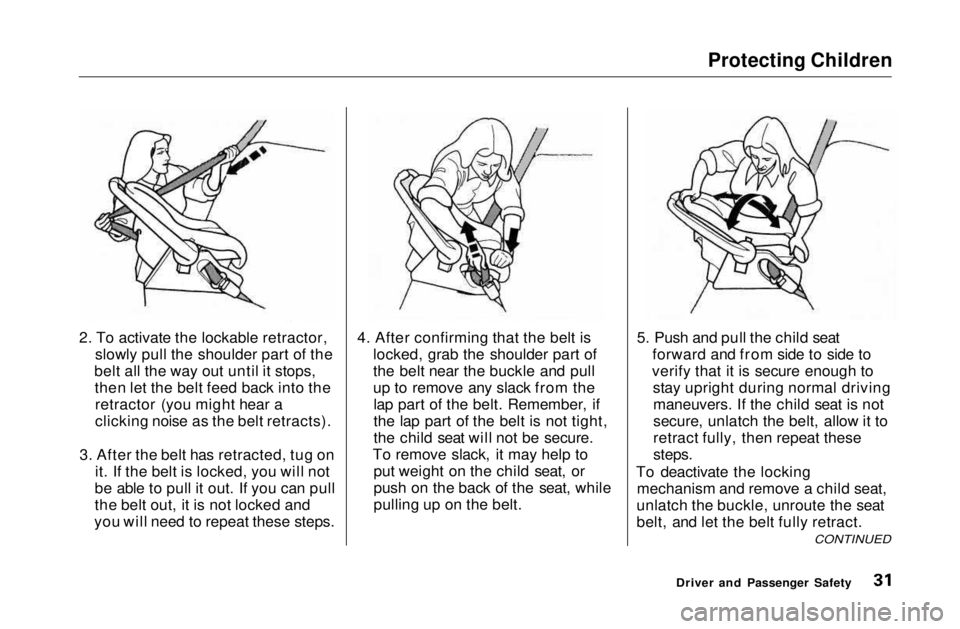
Protecting Children
2. To activate the lockable retractor, slowly pull the shoulder part of the
belt all the way out until it stops, then let the belt feed back into theretractor (you might hear a
clicking noise as the belt retracts).
3. After the belt has retracted, tug on it. If the belt is locked, you will not
be able to pull it out. If you can pull
the belt out, it is not locked and
you will need to repeat these steps. 4. After confirming that the belt is
locked, grab the shoulder part of
the belt near the buckle and pull
up to remove any slack from thelap part of the belt. Remember, if
the lap part of the belt is not tight,
the child seat will not be secure.
To remove slack, it may help to put weight on the child seat, or
push on the back of the seat, while
pulling up on the belt. 5. Push and pull the child seat
forward and from side to side to
verify that it is secure enough to stay upright during normal drivingmaneuvers. If the child seat is not
secure, unlatch the belt, allow it to
retract fully, then repeat these
steps.
To deactivate the locking mechanism and remove a child seat,
unlatch the buckle, unroute the seat
belt, and let the belt fully retract.
Driver and Passenger Safety
CONTINUEDMain Menu Table of Contents s t
Page 33 of 269
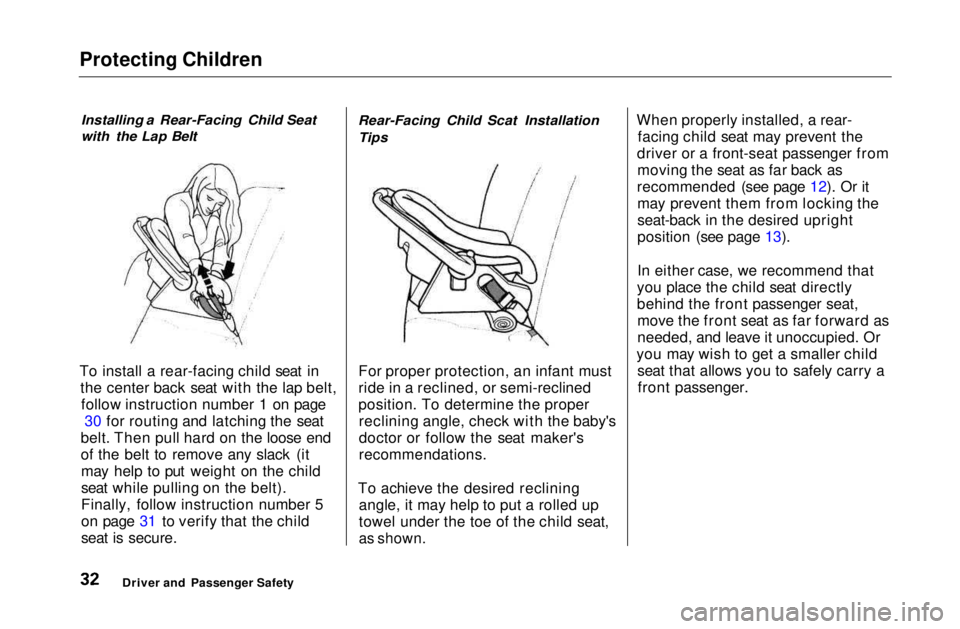
Protecting Children
Installing a Rear-Facing Child Seat
with the Lap Belt
To install a rear-facing child seat in the center back seat with the lap belt,follow instruction number 1 on page 30 for routing and latching the seat
belt. Then pull hard on the loose end
of the belt to remove any slack (it may help to put weight on the child
seat while pulling on the belt).
Finally, follow instruction number 5
on page 31 to verify that the child
seat is secure.
Rear-Facing Child Scat Installation
Tips
For proper protection, an infant must
ride in a reclined, or semi-reclined
position. To determine the properreclining angle, check with the baby's
doctor or follow the seat maker's
recommendations.
To achieve the desired reclining angle, it may help to put a rolled up
towel under the toe of the child seat,
as shown.
When properly installed, a rear-
facing child seat may prevent the
driver or a front-seat passenger from moving the seat as far back as
recommended (see page 12). Or it may prevent them from locking the
seat-back in the desired upright
position (see page 13).
In either case, we recommend that
you place the child seat directly
behind the front passenger seat, move the front seat as far forward as
needed, and leave it unoccupied. Or
you may wish to get a smaller child seat that allows you to safely carry afront passenger.
Driver and Passenger SafetyMain Menu Table of Contents s t
Page 34 of 269
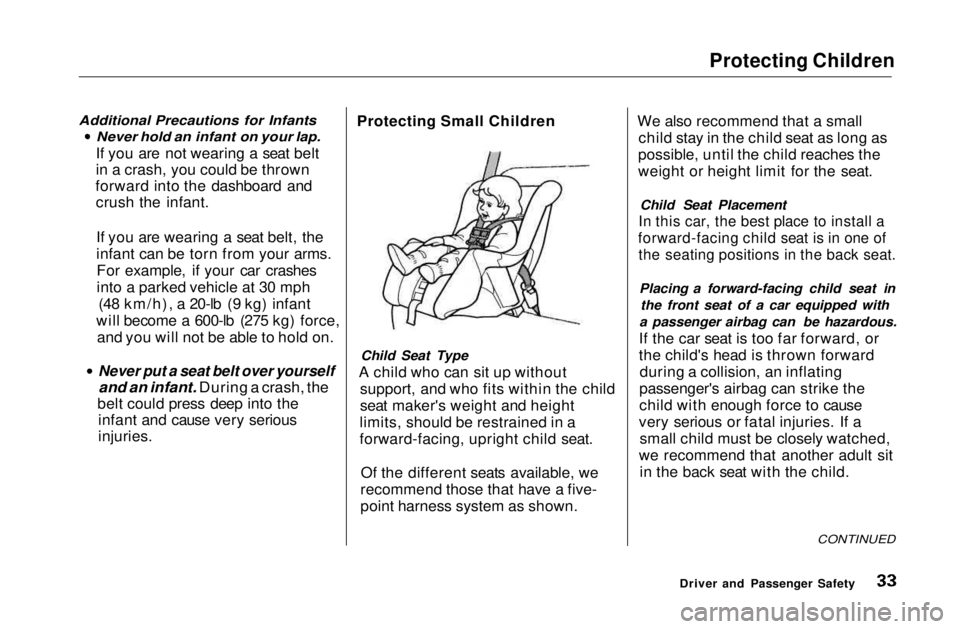
Protecting Children
Additional Precautions for Infants Never hold an infant on your lap.
If you are not wearing a seat belt
in a crash, you could be thrown
forward into the dashboard and crush the infant.
If you are wearing a seat belt, the
infant can be torn from your arms.For example, if your car crashes
into a parked vehicle at 30 mph (48 km/h), a 20-lb (9 kg) infant
will become a 600-lb (275 kg) force, and you will not be able to hold on.
Never put a seat belt over yourself
and an infant. During a crash, the
belt could press deep into the infant and cause very serious
injuries. Protecting Small Children
Child Seat Type
A child who can sit up without support, and who fits within the child
seat maker's weight and height
limits, should be restrained in a
forward-facing, upright child seat.
Of the different seats available, we
recommend those that have a five-
point harness system as shown. We also recommend that a small
child stay in the child seat as long as
possible, until the child reaches the
weight or height limit for the seat.
Child Seat Placement
In this car, the best place to install a
forward-facing child seat is in one of
the seating positions in the back seat.
Placing a forward-facing child seat in the front seat of a car equipped with
a passenger airbag can be hazardous.
If the car seat is too far forward, or
the child's head is thrown forward during a collision, an inflating
passenger's airbag can strike the
child with enough force to cause
very serious or fatal injuries. If a small child must be closely watched,
we recommend that another adult sit in the back seat with the child.
CONTINUED
Driver and Passenger SafetyMain Menu Table of Contents s t
Page 36 of 269
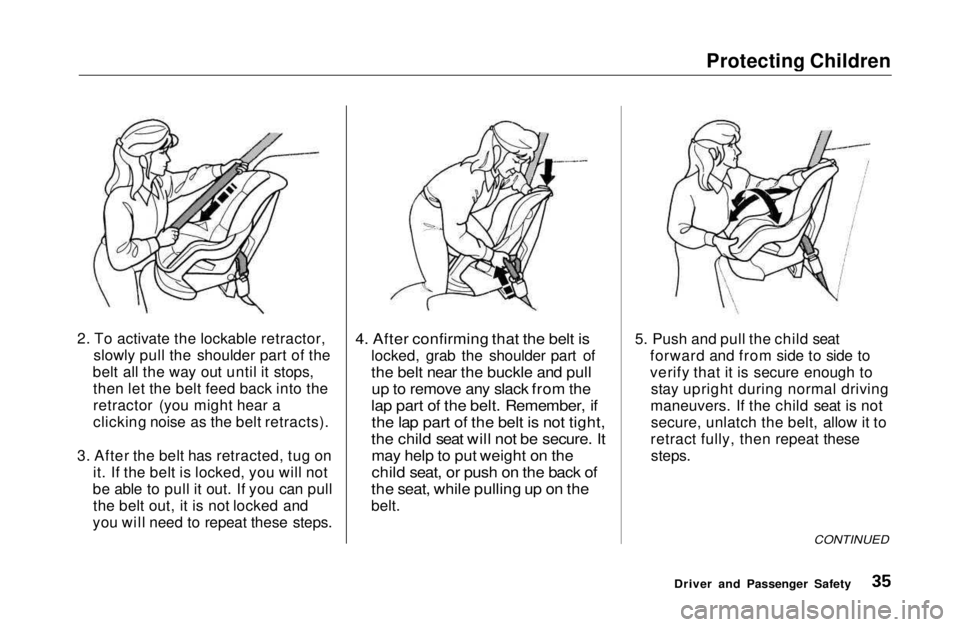
Protecting Children
2. To activate the lockable retractor, slowly pull the shoulder part of the
belt all the way out until it stops, then let the belt feed back into the
retractor (you might hear a
clicking noise as the belt retracts).
3. After the belt has retracted, tug on it. If the belt is locked, you will not
be able to pull it out. If you can pull the belt out, it is not locked and
you will need to repeat these steps.
4. After confirming that the belt is
locked, grab the shoulder part of
the belt near the buckle and pullup to remove any slack from the
lap part of the belt. Remember, if
the lap part of the belt is not tight,
the child seat will not be secure. It
may help to put weight on the
child seat, or push on the back of
the seat, while pulling up on the
belt. 5. Push and pull the child seat
forward and from side to side to
verify that it is secure enough tostay upright during normal driving
maneuvers. If the child seat is not secure, unlatch the belt, allow it to
retract fully, then repeat these
steps.
CONTINUED
Driver and Passenger SafetyMain Menu Table of Contents s t
Page 37 of 269
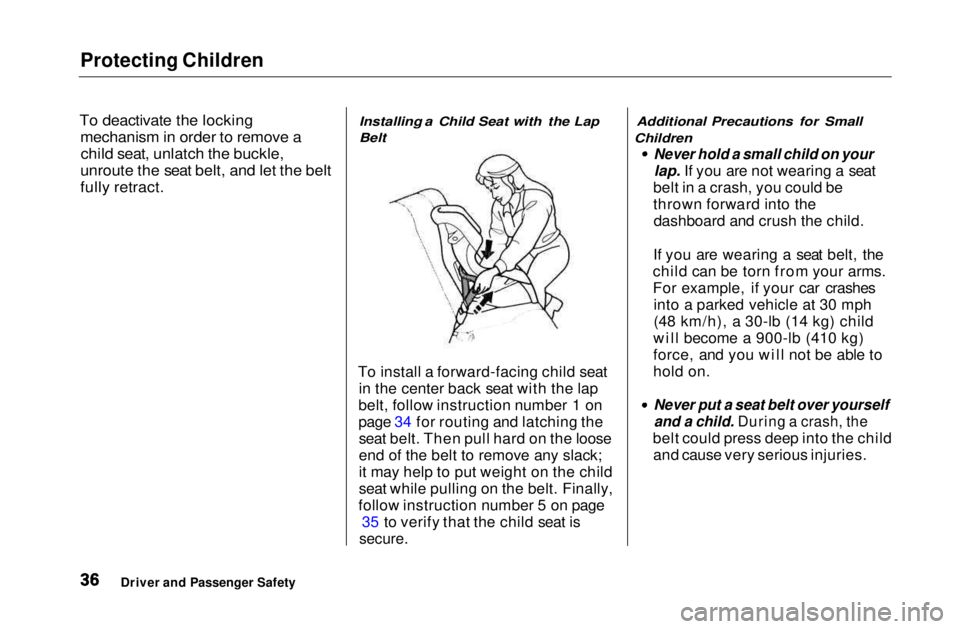
Protecting Children
To deactivate the locking mechanism in order to remove a
child seat, unlatch the buckle,
unroute the seat belt, and let the belt
fully retract.
Installing a Child Seat with the Lap
Belt
To install a forward-facing child seat in the center back seat with the lap
belt, follow instruction number 1 on
page 34 for routing and latching the seat belt. Then pull hard on the loose
end of the belt to remove any slack;
it may help to put weight on the child
seat while pulling on the belt. Finally,
follow instruction number 5 on page 35 to verify that the child seat is
secure.
Additional Precautions for Small
Children
Never hold a small child on your
lap. If you are not wearing a seat
belt in a crash, you could be
thrown forward into the dashboard and crush the child.
If you are wearing a seat belt, the
child can be torn from your arms.
For example, if your car crashes into a parked vehicle at 30 mph
(48 km/h), a 30-lb (14 kg) child
will become a 900-lb (410 kg)
force, and you will not be able to
hold on.
Never put a seat belt over yourself
and a child. During a crash, the
belt could press deep into the child and cause very serious injuries.
Driver and Passenger SafetyMain Menu Table of Contents s t
Page 38 of 269
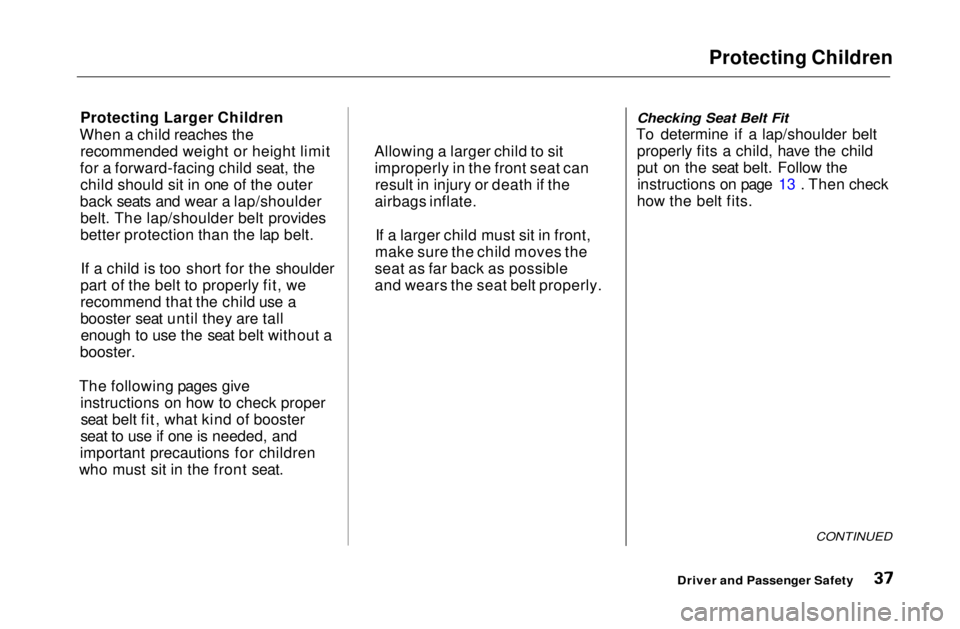
Protecting Children
Protecting Larger Children
When a child reaches the recommended weight or height limit
for a forward-facing child seat, the child should sit in one of the outer
back seats and wear a lap/shoulder belt. The lap/shoulder belt provides
better protection than the lap belt.
If a child is too short for the shoulder
part of the belt to properly fit, we
recommend that the child use a
booster seat until they are tall enough to use the seat belt without a
booster.
The following pages give instructions on how to check properseat belt fit, what kind of booster
seat to use if one is needed, and
important precautions for children
who must sit in the front seat.
Checking Seat Belt Fit
To determine if a lap/shoulder belt properly fits a child, have the child
put on the seat belt. Follow theinstructions on page 13 . Then check
how the belt fits.
CONTINUED
Driver and Passenger Safety
Allowing a larger child to sit
improperly in the front seat canresult in injury or death if the
airbags inflate.
If a larger child must sit in front,
make sure the child moves the
seat as far back as possible
and wears the seat belt properly.Main Menu Table of Contents s t
Page 76 of 269
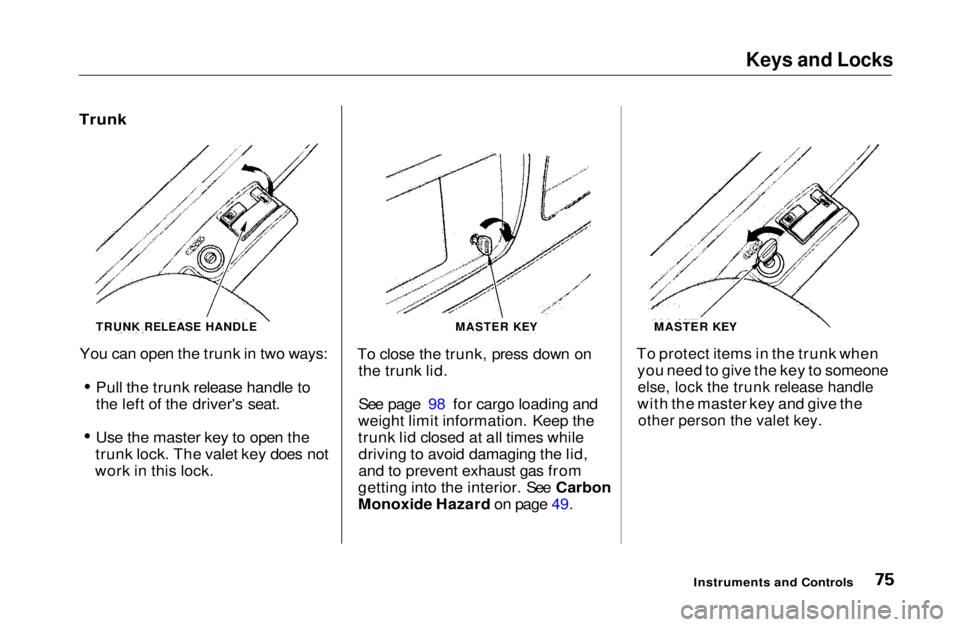
Keys and Locks
Trunk
You can open the trunk in two ways: Pull the trunk release handle to
the left of the driver's seat.
Use the master key to open the
trunk lock. The valet key does not
work in this lock. To close the trunk, press down on
the trunk lid.
See page 98 for cargo loading and
weight limit information. Keep the
trunk lid closed at all times while driving to avoid damaging the lid,
and to prevent exhaust gas from
getting into the interior. See Carbon
Monoxide Hazard on page 49. To protect items in the trunk when
you need to give the key to someone
else, lock the trunk release handle
with the master key and give the
other person the valet key.
Instruments and Controls
TRUNK RELEASE HANDLE
MASTER KEY
MASTER KEYMain Menu Table of Contents s t